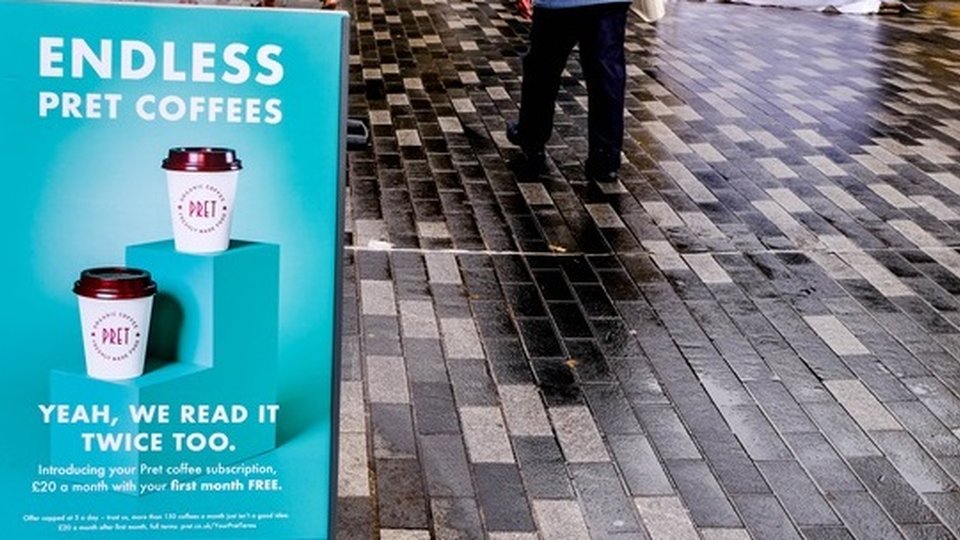Operations
Pret A Manger: Something's brewing in the subscription economy

December 2, 2020 by Sean Keith
Amazon Prime. Ipsy. HelloFresh. Dollar Shave Club. Stich Fix. BarkBox. Netflix. Ten years ago, this list would've been a list of nonsense words bookended by Amazon and that company that sends DVDs to your house. Now. they're the stars of the subscription economy.
You know what you don't see on that list? Restaurants. Grocery delivery and meal kits are on the subscription model, but foodservice is underrepresented in the subscription economy. The good news is, that's changing.
The subscription economy is undeniable. Check the numbers, which show that subscription businesses have grown 400% over the past 8 ½ years and have grown revenues six times faster than the S&P 500. Better yet, check the recurring charges on your bank statement: chances are, you probably have a few subscriptions from the list above, including 3.4 streaming services.
If the subscription economy is popular and convenient for consumers, it can be a lifeline for businesses, including restaurants. The recurring revenue subscriptions provide has buttressed declines in operational revenue. Also, with 70% of subscription revenue on average coming from existing customers, subscriptions help increase customer lifetime value and keep brands top-of-mind for their best clientele.
For all of these reasons, Pret A Manger became the latest foodservice chain to join the subscription economy, launching the YourPret Barista program last month. By doing so, it's not only deployed the first barista coffee subscription service in the UK, it demonstrates a sustainable path to growth even amid ongoing uncertainty. (Earlier this year, Panera and Corner Bakery launched subscription models this year in the U.S.)
How YourPret Barista Works
YourPret Barista is a straightforward subscription proposition that offers members up to five drinks per day in exchange for a monthly fee. It costs 20 pounds ($26.60) per month and includes all barista-made coffees, teas, hot chocolates, smoothies and frappe drinks, with a minimum 30-minute wait between orders to manage demand and subscription use. A QR code that each subscriber accesses through their mobile wallet is scanned at checkout to complete the transaction.
Value is integral to the program. For a daily coffee drinker, YourPret Barista pays for itself in a week. That's a savings proposition that's easy to understand, which helps attract subscribers and drive ongoing membership growth, as well as driving higher check values from top-up buys. For Pret A Manger, which in normal times enjoyed the heavy lunchtime foot traffic typical of fast casual restaurants in city centers and financial districts, it's a way to recoup revenue lost by the decline in their core business while still leaning into a trend of rising coffee sales.
But there's a reason that subscription services haven't previously been widely adopted by restaurants and other hospitality companies. To get the most out of YourPret Barista, Pret A Manger had to invest in its digital technology platform.
Overcoming tech limitations
Many restaurants — including most fast casual chains — have a direct connection with their customers through a loyalty program. They may even have an online presence or an app but rarely will have the capacity (or the resources) to combine and analyze sales and loyalty data to gain comprehensive insights into their customers, let alone tie their activity back to a sale. It's not a lack of willpower; rather, legacy systems hold them back from building a personalized digital connection with customers. A subscription service like YourPret Barista requires one-to-one connections that can be leveraged at checkout, which is beyond the reach of most existing restaurant POS and back-end systems.
To overcome these limitations, Pret A Manger implemented a digital infrastructure with digital service capability in the store that allows the company to launch customer propositions more quickly and at scale. This tech platform facilitates the distribution of unique digital vouchers to each subscriber (which manifest as the QR codes mentioned earlier), and integrates with Pret's instore Oracle MICROS Simphony point-of-sale system. Most importantly, this investment in digital technology provides the back-end data connectivity that fuels activity tracking and customer insights.
What Pret gets
The real value of subscription loyalty programs like YourPret Barista is the digital connection they create between the restaurant and its customers. By linking online interactions with in-store transactions through the subscription loyalty program, Pret A Manger can engage with its customers on an individual basis. That means they can begin to offer personalized digital offers, recommendations and incentives in real time, which are some of the same digital marketing tools that Amazon and other ecommerce giants have used to good effect for years.
The ability to collect data from customer interactions both online and in person, link those interactions and transactions through the program, and deploy promotions and marketing communications automatically enables Pret a Manger to develop deeper relationships with its customers that deliver loyalty, increased frequency and higher average customer lifetime value.
The take-out takeaways
The biggest takeaway other restaurant chains and foodservice entities should keep in mind as they enter into the subscription economy is that the connection to the customer is paramount. In the near term, similar initiatives, such as the MyPanera+ Coffee subscription by Panera, can have a positive impact on frequency and check average, but their ability to engage with customers digitally and in store will pay the real dividends, if handled correctly.
Recurring revenue is great, but it only recurs if customers continue to find value in the subscription. By having the infrastructure in place to create digital connections, restaurant brands can understand their customers better and create offers and incentives that deliver that value and keep subscriptions active. This is how they can use digital to win in the subscription economy.







